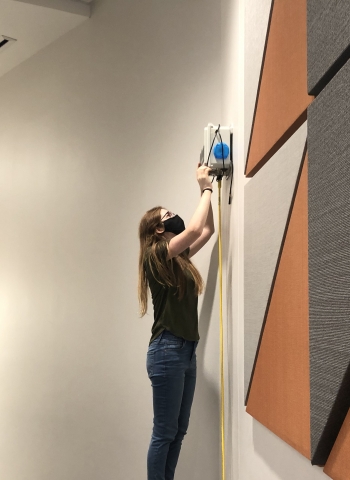As the Covid-19 pandemic has increased the importance of assessing indoor air quality and ventilation in public spaces such as universities, Georgia Tech researchers have identified that in-situ measurements of either carbon dioxide (CO2) or particulate matter (PM) by low-cost sensors can be used to perform such calculations in classrooms – an insight that could be useful for schools with limited resources or access to only one type of air quality monitor.
Measuring indoor pollutant levels provides initial insight into indoor air quality, but a more comprehensive metric to understand indoor air quality and pollutant exposure is the air change rate, or air changes per hour (ACH) – the number of times that the total air volume in a room or space is removed and replaced in an hour, explained Nga Lee “Sally” Ng, Love Family Professor in Georgia Tech’s School of Chemical and Biomolecular Engineering and School of Earth and Atmospheric Sciences.
Her research team monitored a large lecture hall at Georgia Tech over extended periods of time in Spring and Fall 2021, measuring the levels of CO2 and aerosols, also known as PM, using low-cost sensors. Exposure to PM with a diameter smaller than 2.5 mm (PM2.5) has been associated with cardiopulmonary diseases and millions of deaths per year. Over the course of the pandemic, it is also becoming clear that aerosols can spread the Covid-19 virus through the air.
CO2 and PM levels can vary substantially in the classroom depending on the time of day. Student breathing during class times increases CO2, while their movements can resuspend PM that had deposited to surfaces into the air. Periodic cleaning (fogging) of the classroom during 2021 also generated aerosols.
In a paper published in the journal Building and Environment, the researchers reported that measuring CO2 levels alone over extended time periods should be sufficient to predict the decay rate of aerosols in a room. Both CO2 and PM provide comparable estimates of air change rates.
CO2 monitors are low cost and more accessible to institutions with limited resources than advanced techniques involving the release of chemicals into the air to measure air change rates, Ng said. PM monitors are also relatively inexpensive and could provide an even better picture of aerosol dynamics, she added.
“In reality, there are many situations in which someone wishing to use a PM or CO2 sensor to evaluate the risk of a virus transmission will only have access to a single sensor and limited other resources,” said PhD student Sabrina Westgate, the lead author of the paper. “The analysis provided in this work presents a case for the feasibility of using either a low-cost CO2 or PM sensor to do just this.”
But the key is continuous measurement over a long period of time to characterize the air change rates, Westgate said. If the calculated air change rate of a room regularly falls below recommended values, it indicates that room ventilation or particle removal methods (such as installing portable air cleaners) should be improved, or that breaks between classroom use should be increased.
Professor Ng said, “To our knowledge, this is the first study that comprehensively evaluates and compares the decay rates of occupant-emitted CO2 and particles of different sizes (PM1, PM2.5, and PM10) in a mechanically ventilated, university classroom using in-situ measurements. Our results provide new, data-driven insights into the practicality of using in-situ air quality monitoring to evaluate ventilation.”
The team employed a technique commonly used to quantity ventilation – analyzing the decay rate of tracer gases – to determine and compare occupancy-based CO2 and PM decay rates.
This specific study focused on a single classroom, but it is part of a larger project by Ng’s team to continuously monitor air quality in more than 30 classrooms across the Georgia Tech campus since 2020. The team has worked with the company QuantAQ to install sensors in these classrooms. The sensors are providing real-time air quality data that will help guide future measures to improve air quality.
Ng credits Georgia Tech’s Departments of Environmental Health and Safety and Facilities Management for their efforts to improve air quality on campus, including installing air purifiers, during the pandemic.
“Indoor air quality is an important topic, and a pandemic makes it even more so,” says Ng, whose research focuses on aerosol chemistry, air quality, and health effects.
CITATION: Westgate, S., and Ng, N. L.: Using in-situ CO2, PM1, PM2.5, and PM10 measurements to assess air change rates and indoor aerosol dynamics, Building and Environment, 109559, https://doi.org/10.1016/j.buildenv.2022.109559, 2022.
FUNDING: This work is supported by the GT Covid-19 Rapid Response fund and the NSF Graduate Research Fellowship under Grant No. DGE-2039655.
Any opinions, findings, and conclusions or recommendations expressed in this material are those of the authors and do not necessarily reflect the view of the sponsoring agency.
For More Information Contact
Brad Dixon, braddixon@gatech.edu





